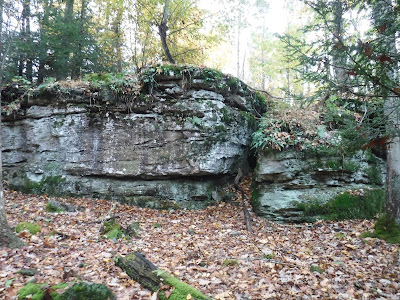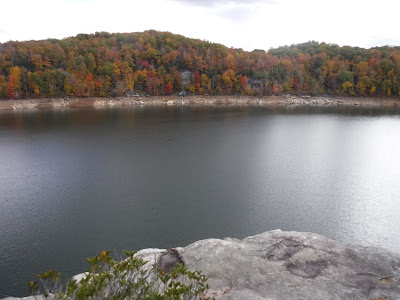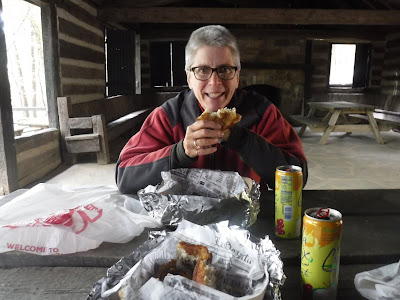Well, here we are in Summersville, West Virginia. We are staying in a campground on a cliff overlooking Summersville Lake, and under the shadow of the Summersville Lake Lighthouse:
Weather will not be our friend at this stay; a huge storm is hitting us as we write this blog entry. We knew that we would only have today to get out on foot to explore the nearby New River Gorge National Park and Preserve.
After breakfast and the morning kitty walk, we drove to a nearby CVS to get our booster Covid shots, then hightailed it to the national park visitor center to learn as much as we could about the park before picking a trail to hike:
The visitor center is a stone, modern-design building with clean lines that reminds us of the stony cliffs of the New River Gorge:

The visitor center gave us an opportunity to learn about the geologic and human history of the gorge, which was carved, possibly 300 million years ago. In this sense, the New River is anything but new. Dating back to the days of the supercontinent Pangaea, it is one of the oldest rivers in the world and one of the few waterways in North America that runs north. The New River was born when the North American and African plates collided to form the supercontinent Pangaea. The impact uplifted the Appalachian Mountains to Himalayan heights, and a mighty river named the Teays formed to drain the western slopes of the range. From its headwaters in what is now western North Carolina, the Teays flowed north through the Virginias before turning west into the Ohio River Basin, eventually draining into a vast inland sea. Today the New River begins in the same headwaters carved by the Teays and follows roughly the same northward path. Around 60 million years ago, the diagonally trending ridges of the Appalachians went through a period of uplift, but the highly erosive Teays kept cutting into the mountains faster than the uplift rate. Thus, the river’s south-to-north course runs counter to the west-to-east flow of most Appalachian waterways, carving a formidable 400-meter-deep river canyon directly through the Appalachian Plateau.
Here, in southern West Virginia, a road was cut in the late 1800's down into the gorge, a bridge constructed over the river, and a road cut up the other side. It met the tracks of a railroad along the river, helping to transport coal from 3-foot seams in the cliffs above the New River to various markets around the country. Eventually, however, time passed this area by. The coal mines closed, and the bridge was condemned. In 1977, a new, spectacular bridge was constructed in its place:

The present bridge is a steel arch bridge 3,030 feet long, supported by an arch 1,700 feet long. It was the world's longest single-span arch bridge for 26 years. It spans the gorge 876 feet above the New River, making the bridge one of the highest vehicular bridges in the world; it is the third highest in the United States. Because of its height, the bridge has attracted daredevils since its construction. It is now the centerpiece of the annual "Bridge Day", during which hundreds of people, with appropriate equipment, are permitted to climb on or jump from the bridge. In 2005, the structure gained additional attention when the US Mint issued the West Virginia state quarter with the bridge depicted on one side. In 2013, the bridge was listed on the National Register of Historic Places.
We had a view of the bridge from an observation platform near the visitor center, where David also got pictures of the New River itself as it plowed through its gorge:
Here is a closer view of the river, showing a small vehicular-and-pedstrian bridge that is a replica of the original 1800's bridge:
Referring to park information we got at the visitor center, we decided to use our precious time today to hike the Endless Wall Trail, which, with a half-mile section of road, forms a 3-mile loop trail that took us along the tops of the dramatic, sheer vertical sandstone walls of the gorge. Here, we started our hike:
As with most national parks, this trail was well-constructed and maintained, including some heavy wooden-beam bridges over the small creek that winds through this section of the park:
Once we got out to the rim, we gained a good view of the sandstone cliffs of the "Endless Wall":
Several viewpoints along the cliff offer dramatic views of the gorge and river:
At Diamond Point, Kathy found a lone tree set bravely out on a cantilevered rock, and decided to join it in the blustery wind:
Nearing the end of our rim walk, we found another viewpoint, where Kathy paused to appreciate a beak-nosed sandstone point on the wall opposite our position:
David wasn't the only one to find solid wooden bridges. Kathy liked this one and showed it off:
The gorge supports an almost rainforest-type climate, as witnessed by this rare silver fern --
-- and this tree-ear mushroom! We have never seen either of these before in all of our hikes.
Finishing our hike, we hopped in the Jeep and drove down the old road to the river level in the gorge. This road is part of the national park and is maintained as part of its attractions. The road took us over the replica of the original vehicle bridge that was replaced in 1977:
We hopped out of the Jeep, walked out onto the replica bridge, and were treated with this gorgeous view of the new bridge span:
Time was a-wasting. We needed to get home to give the kittens their afternoon walk. The storm was approaching. We were getting hungry. So we hustled back to our RV to plan another day-long driving tour of this large national park in one of the two rainy days that remain to us here. Stay tuned!


























































